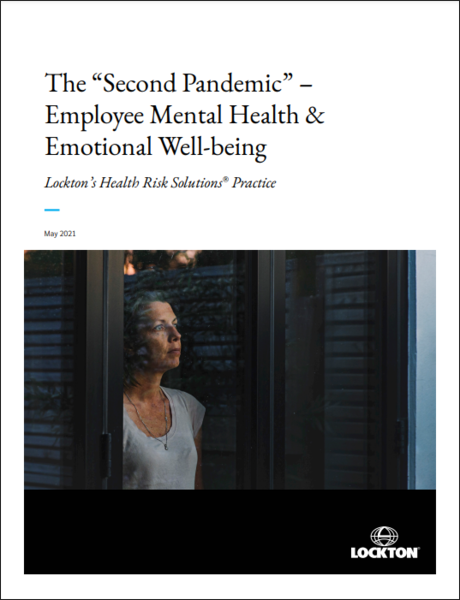Mental health and emotional well-being are top of mind for most employers today, with the toll of the pandemic and other issues having a heavy impact on many employees. And as challenging as loneliness and stress have been for people during the last year, the transition back into the workplace will bring new issues. During Mental Health Awareness month, we want to share some recent research and what your company can do to help employees navigate the changing landscape and build resilience.
After one year of the pandemic, things have changed
According to the National Alliance on Mental Illness, before 2020, one in five adults in the U.S. reported having a mental health condition and research now indicates that figure may be two in five, or even higher.
Economic uncertainty, fear of COVID-19 and social isolation have been stressful to employees and their families. We saw mental health and behavioral health claims increase over the course of 2020 and expect this to continue into 2021 and possibly beyond.
In Lockton’s Infolock® data, we see evidence of utilization changes in behavioral health visits, specifically in telehealth claims. Prior to COVID-19, upper respiratory symptoms were some of the most frequent diagnoses for virtual visits. During COVID-19, the proportion of telehealth visits associated with a mental health diagnosis more than doubled.
Late last year, the American Psychological Association issued a warning about the impact of recent events on the long-term physical and mental health of Americans. They said we faced “a second pandemic — one that would persist even after the physical threat of the virus has been addressed.”
Their research found that peoples’ physical health may be declining due to an inability to cope in healthy ways with the stresses of the pandemic. For example, people said they had gained or lost an undesired amount of weight, were drinking more alcohol to cope with stress and that their mental health had worsened.
Analyzing data from Infolock, Lockton’s data platform of more than 3.5 million members, we see increases in mental health treatments and prescription medications.
Comparing data from April 2019 through February 2020 and April 2020 through February 2021, we found:
7% increase in anti-anxiety medications
4.4% increase in antidepressant medications
4.6% increase in the broader Mental Health drug category
10.9% increase in the utilization rate for behavioral health visits
The increase in behavioral health visits was especially interesting as there was a decrease in behavioral health visits from April through June 2020.
THE IMPACT ON EMPLOYERS IS SIGNIFICANT. According to the American Psychiatric Association 1 , less than half of people with mental health conditions, including depression, receive treatment. The reality is that people with chronic health conditions are at higher risk for depression, and those with depression are at higher risk for chronic health conditions. And the costs for treating chronic health conditions - like musculoskeletal, cancer, diabetes and heart disease – is two to three times higher for those with co-morbid mental health and substance use conditions.
Like any health condition, early detection and treatment for mental health conditions and depression can help people keep their work and personal lives on track. With effective treatment, people are more engaged in work, miss fewer days and perform at their full potential, improving presenteeism and absenteeism.
What steps can employers take to support their workforces?
“There are several ways that employers can assist employees,” said Kembre Roberts, Vice President, Well‑being
Practice Leader at Lockton. “The spectrum of solutions spans from strategies to help members cope to situational programs focusing on specific issues to clinical solutions that address medical conditions.”
She added, “It is important for employers to reduce the stigma around mental health struggles because this often prevents people from seeking the help they need.”
One resource Roberts recommends for employers is the Center for Workplace Mental Health’s toolkit (opens a new window). It provides a range of tips and resources to help support mental health and well-being at work.
Support foundations with new strategies and tools
Most employers have many of the foundational elements of a holistic well-being and mental health program already in place. Your company may have an EAP, a wellness program and offer financial counseling through your retirement plan. Companies can consider rounding out programs with new strategies to address other areas of workforce stress and to help employees re-engage as they return to work sites. This might mean forming Employee Resource Groups (ERG) to connect employees around a common purpose or sponsoring activities around shared interests, like a book clubs or a running group.
Best practices to optimize mental health and well-being programs
According to Sarah Lytton, MS RDN/LDN and Vice President, Director of Health Risk Solutions at Lockton, “Employers should consider a range of strategies to continue to optimize mental health and well‑being programs.” Lytton continued, “To maximize a programs’ impact, employers can look for opportunities to connect or package similar resources together and create communication strategies that meet members where they are.“
LOCKTON HAS FOUND IT IS VITAL FOR COMPANIES TO:
ALIGN MENTAL WELL-BEING TO CORPORATE CULTURE. Identify organizational goals, discuss human capital philosophy and commit to supporting employees’ mental health.
HAVE STRONG LEADERSHIP COMMUNICATION. Strong and clear communications from onboarding to manager training on behavioral health to ongoing employee messaging to remove stigmas.
INTEGRATE NEW SOLUTIONS AND TOOLS INTO CURRENT BENEFITS PROGRAMS. Address network gaps, ensure telemedicine includes behavioral health, explore EAP program enhancements and disease management outreach are some strategies to review
HELP FOSTER EMPLOYEES’ SKILLS FOR MENTAL WELL-BEING. Individual counseling, stress management and resiliency courses, access to free screenings and support for personal issues, and ways employers can assist employees.
REMOVE BARRIERS TO ACCESS. Offer employees a variety of access points and minimize stigma. Employers may also want to carve out new behavioral solutions where gaps exist.
Lockton clients with innovative and comprehensive mental and behavioral health strategies have key processes and considerations in place.
Lockton helps you understand your specific workforce needs today and customize programs that meet your business objectives and improve employee health and well-being. Your Lockton consultant can work with you to navigate the shifting landscape to help deliver better employee health outcomes in a post-COVID-19 world. Download article (opens a new window)
Download article (opens a new window)
1 https://workplacementalhealth.org/employer-resources/infographic-depression
